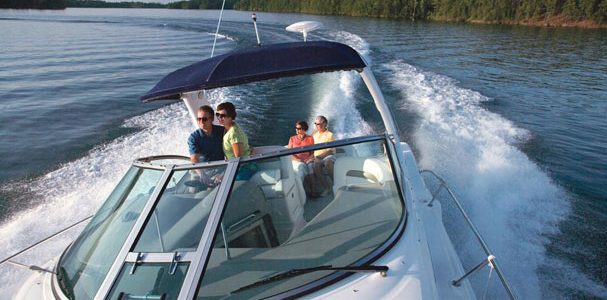
Articles & News
Boating Tips For Lake Martin: Winterize Your Boat in 10 Easy Steps
Published: 09.26.2013
As the cooler weather sets in on Lake Martin, don’t forget to get your boat ready for the winter ahead. The care you take now will pay off on that first perfect spring day!
1. Flush outboard engines with fresh water. Let all water drain. Wash engine with soap and water. Rinse thoroughly. Disconnect the fuel hose and run the engine until it stops. Lubricate cylinder walls and pistons with fogging oil. Change gear oil. Lubricate engine exterior.
2. Run your inboard engine. Change the oil while it’s warm to allow impurities to drain away. Change the oil filter. Flush engine with fresh water. Circulate antifreeze through the manifold. Start engine and allow antifreeze to circulate until water starts to exit the exhaust. Remove spark plugs and lubricate with fogging oil.
3. Inspect the stern drive. Remove any plant life or barnacles from the lower unit. Drain the gear case and check for excessive moisture in the oil, which could indicate leaking seals and the need for repairs. Clean lower unit with soap and water. If your stern drive has a rubber boot, check it for cracks or pinholes. Grease all fittings. Check fluid levels in the hydraulic steering or lift pumps.
4. Fill your fuel tank(s). This avoids a build up of condensation over the winter months. Add a fuel stabilizer by following the instructions on the product. Change the fuel filter(s) and water separator(s).
5. Make sure the bilges are clean and dry. Use soap, hot water and a stiff brush to clean up any oil spills. Once bilges are clean, spray with a moisture displacing lubricant and add a little antifreeze to prevent any water from freezing.
6. Drain the fresh water tank and hot water heater. Isolate the hot water heater by disconnecting the in and out lines and connecting them together. Pump a non-toxic antifreeze into the system. Turn on all the faucets, including the shower and any wash-down areas until you see the antifreeze coming out. Put non-toxic antifreeze in the water heater.
7. Pump out the head holding tank at an approved facility. While pumping, add fresh water to the bowl and flush several times. Clean head. Add fresh water and pump out again. Add antifreeze and pump through hoses, holding tank, y-valve, macerator and discharge hose.
8. Leave a battery board to operate a burglar alarm or bilge pump. Both are useful during the winter months. Make sure the battery cells are filled with distilled water and fully charged so they don’t freeze. Frozen cells will ruin a battery. Clean the terminals with baking soda, and rinse with cold water. Coat the terminals and cables with petroleum jelly to help prevent rust. If you don’t need a battery aboard, take it home and do all of the above. Store batteries in a cool dry room, and put them on a trickle charger, or charge them every 30 to 60 days.
9. Cover your boat to keep it boat clean and free from dirt, water, and leaves – all of which can cause damage if left unchecked. A cover also prevents UV rays from breaking down hoses and fading carpets and upholstery. During the winter, use a frame under the cover to distribute the weight of water or snow that may collect on the boat.
10. Review your marina or boatyard contract. Make sure you know what services you’ll receive and what you’re responsible for providing through the winter. Most marinas and yards only store your boat, and maintenance or winter preparation services typically cost extra.
Visit Russell Marine to learn more about winterizing your boat, location details, and more.


